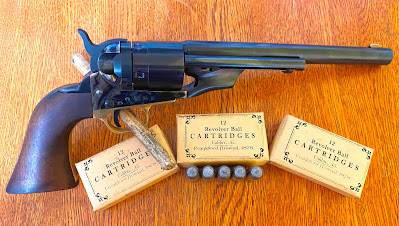Introduction
There was a lot going on today, although not as much as I'd hoped. I shot 3 tables of fire with the .45 Colt Conversion revolver using the Kirst Konverter installed for me by Gary Barnes of Gary Barnes Cartridge Conversions for target score, plus one table of fire using the Snap Shooting process described below. I also shot 4 tables of fire using Kerr paper cartridges from my Remington New Model Army that Gary Barnes modified for me to better accept paper cartridges. I had intended to shoot several tables of fire with the Remington using Johnston and Dow paper cartridges, however, I found that they are so tall that despite Mr. Barnes' work my revolver still won't take them (which is not a criticism of Mr. Barnes--I sent him dummy Kerr paper cartridges for him to use to gauge his work, and those feed *perfectly*).
 |
| Colt Cartridge Conversion with replica cartridge packs. |
 |
| Remington New Model Army with reproduction Eley Bros. cap tin and J&D cartridge packs. |
Conditions
Location: Lytle Creek. Temperature: 78-86 degrees. Clear and partly cloudy. Wind: ~4 m.p.h. from 8:00. Humidity: 57%. Range: 15 yards. Shooting Position: Seated unsupported for all except the snap shooting, which was done one-handed standing. Note that the black circles I put on the targets are 3 inches in diameter.
Ammunition
.45 Colt: 35 grains of Schuetzen 3F powder and a 250-grain Lee RNFP bullet cast from pure lead and greased with lamb's tallow and beeswax. Starline brass and CCI large pistol primers. Packaged in replica Frankford Arsenal cartridge packages. The average muzzle velocity was 788.1 fps, giving a muzzle energy of 345 ft.-lbs. I need to get better at loading .45 Colt; all the cartridges passed the micrometer size test, but a few were too large at the base so they fit into the chamber but not far enough to allow the cylinder to rotate.
Kerr Cartridges: .44-caliber Kerr bullets cast from pure lead with 25 grains of Schuetzen 3F powder in shells made from nitrated coffee filters. For details of how I make paper cartridges, see the link HERE.
The String Test
The String Test is a method of gauging accuracy that was actually used during the Civil War and is vastly superior to simply measuring the group size since it takes both the group size and the distance from the mean center of the group to the bullseye into account in the same number, so it is a much more meaningful way to gauge your accuracy despite being incredibly easy to do. All shooters, and certainly all historical shooters, should be using this test. You can learn more about the String Test at the link HERE.
String Test: 10.25 in./6 rounds = 1.7 in./rd.
Remington NMA with Kerr 25-grain combustible cartridges.
String Test: 11.0 in./6 rounds = 1.8 in./rd.
 |
| Tables One and Two. |
Colt Conversion with .45 Colt cartridges.
String Test: 17.25 in./6 rounds = 2.9 in./rd.
Colt Conversion with .45 Colt cartridges.
String Test: 10.25 in./4 rounds = 2.6 in./rd.
 |
| Tables Three and Four. |
Table Five
Remington NMA with Kerr 25-grain combustible cartridges.
String Test: 11.5 in./6 rounds = 1.9 in./rd.
 |
| Table Five. |
Colt Conversion with .45 Colt cartridges.
String Test: 20.0 in./10 rounds = 2.0 in./rd.
Remington NMA with Kerr 25-grain combustible cartridges.
String Test: 8.5 in./6 rounds = 1.4 in./rd.
Colt Conversion with .45 Colt cartridges.
Hit Rate: 9 hits/10 shots = 90%
 |
| Table Eight. |
The Colt Conversion is, as is typical of Colts, shooting high. I did not attempt to aim off since I wanted to get an idea of how the weapon was shooting. Now that I know, I can aim off slightly below the target to bring my Mean Point of Impact closer to my Intended Mean Point of Impact (the Bullseye). This will improve the string test results significantly. However, note that the average for all tables of fire with the Colt was 2.4 in./rd.; considering that my averages with my Remington cap and ball (before it was worked on) were between 2-4 in./rd., it is clear this weapon will be extremely accurate when I finally get it dialed in.







No comments:
Post a Comment